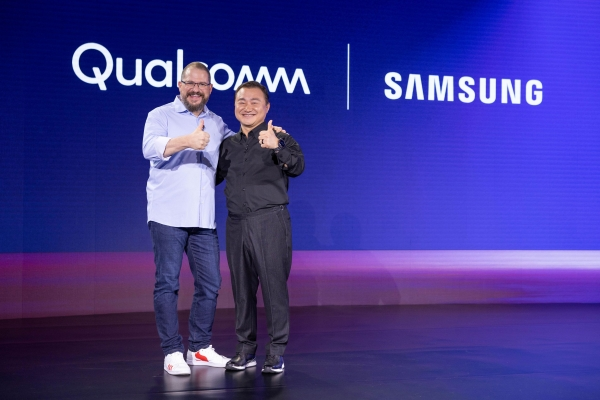Samsung Struggles Under Qualcomm AP Costs, Races to Revive Exynos and Foundry Business
Input
Modified
Rising AP expenses erode internal profitability
Gains from strong sales flow to Qualcomm’s bottom line
Foundry competitiveness emerges as crucial to long-term strategy

Despite robust sales of its latest smartphones, Samsung Electronics is facing a serious profitability squeeze from its dependence on Qualcomm. Application processors (APs) are consuming a growing share of raw material purchases, creating a structural imbalance in which higher handset sales translate into bigger profits for Qualcomm. In response, Samsung is accelerating efforts to revive its Exynos line and strengthen foundry capabilities as part of a broader push to cut costs and reclaim strategic autonomy. Industry observers agree that Samsung’s global prospects hinge on the synergy of “in-house AP plus foundry.”
Qualcomm price hikes weigh on MX Division
According to Samsung’s recently released half-year report, its Device eXperience (DX) division spent about $5.6 billion on mobile AP purchases in the first half of this year, up 29.2 percent ($1.22 billion) from the same period a year earlier. The share of APs in the DX division’s total raw material purchases also rose from 17.1 percent to 19.9 percent, highlighting a mounting cost burden.
The surge stemmed from Samsung’s decision to equip every unit of its flagship Galaxy S25 series, launched earlier this year, with Qualcomm’s Snapdragon 8 Elite AP. Samsung had initially planned to use a mix of its in-house Exynos 2500 and Qualcomm chips, as it did with the Galaxy S24 series, but abandoned the plan due to yield issues. Although the choice reflected strategic considerations of performance and marketability, it left the company exposed to a steep cost wall.
As the “brains” of a smartphone, mobile APs integrate CPUs, GPUs, and other system semiconductors into a single chip, making them critical to performance. Tech giants worldwide pour resources into AP development each year, driving up R&D and production costs that, in turn, push chip prices higher. For handset makers like Samsung, the fierce competition and reliance on advanced process technology translate directly into heavier cost burdens.
The problem is compounded by Qualcomm’s escalating AP prices. Qualcomm relies mainly on Taiwan’s TSMC for production, and TSMC has been aggressively raising process prices. The company’s N3E second-generation 3-nanometer process, used in the Snapdragon 8 Elite, reportedly costs $18,500 per wafer—about 23 percent higher than the $15,000 charged for its earlier 4-nanometer process. TSMC has even signaled plans to raise prices on key nodes such as 3 nanometers by up to 8 percent.
Strong sales, but profits flow outward
Samsung’s inability to fully enjoy the benefits of Galaxy S25’s strong performance stems from this dynamic. The series, enhanced with advanced AI functions, drew strong consumer enthusiasm and sold 3 million units in just two months—faster than its predecessor. Yet those gains flowed largely to Qualcomm, as Samsung kept retail prices in line with previous models. As a result, operating margins at the MX division fell, with Samsung reporting just 10.1 percent for the first half, compared with Apple’s roughly 30 percent margin thanks to its in-house chips.
To improve profitability, Samsung is weighing a significant increase in the use of its Exynos APs. Though the company designs and manufactures Exynos chips through its System LSI and Foundry divisions, past issues of performance and stability had left it heavily reliant on external suppliers. But with AP costs climbing and TSMC raising foundry prices, the case for Exynos has shifted from optional to essential.
Attention now centers on the Exynos 2600, Samsung’s next flagship AP, being developed on its advanced 2-nanometer process. Industry analysts say it has already won favorable reviews for yield and stability through a large supply contract with Tesla. Samsung is reportedly aiming to equip the Galaxy S26 series with the Exynos 2600, possibly making it standard in the base model.
Samsung expects the successful rollout of the Exynos 2600 to generate wide-ranging benefits. Choi Won-joon, head of MX Development at Samsung (and president), recently emphasized the company’s commitment to delivering top-tier performance and user experience, noting that evaluations of the new chip were progressing as planned. Kim Kyung-bin, an analyst at Samsung Securities, added that “flagship adoption of the Exynos 2600 and a foundry turnaround will drive stronger profit expectations next year than this year.”

Foundry competitiveness as the key to Samsung’s “new normal”
Samsung’s renewed focus on in-house APs is more than a cost-cutting measure; it is poised to become a central driver of overall competitiveness. Foundry strength in particular carries strategic weight, reshaping both technological independence and market standing. Today’s advanced foundry market is dominated by TSMC, leaving not only fabless firms like Qualcomm but also customers like Samsung at a disadvantage in price negotiations. Only if Samsung develops its foundry technology enough to create real competition can structural reductions in AP manufacturing costs become possible.
Broader benefits would ripple across Samsung’s semiconductor business. A stronger foundry platform could reinforce competitiveness in memory and system LSI, enhance price efficiency in final products, and boost both market share and profitability. Reduced reliance on outside suppliers would also mitigate external risks from supply chain instability. At a company-wide level, Samsung would gain both cost efficiency and secure component supply.
For now, industry consensus holds that Samsung’s foundry division may need to accept low-margin orders to sustain line utilization and yield stability. Though this may look like a short-term “survival” tactic, in the medium to long term it could elevate advanced process capabilities, strengthen cost competitiveness, and diversify the customer base. Viewed this way, Samsung’s investments in Exynos and its foundry are not merely about cost savings but part of a long-term strategy to secure leadership within the global semiconductor ecosystem.





















